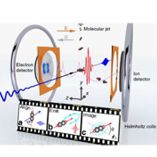2015/06/24
Nature Communications has recently published the work "Imaging an aligned polyatomic molecule with laser-induced electron diffraction" in which ICFO researchers Dr. Michael Pullen, Benjamin Wolter, Matthias Baudisch and Dr. Michael Hemmer, led by ICREA Prof. at ICFO Dr. Jens Biegert, have developed the recipe to take 'snapshots' of polyatomic molecular structure at the atomic level and with attosecond temporal resolution.
Organic compounds are the building blocks of many chemical and biological systems in nature and are therefore vital to life on earth. They are continuously undergoing important structural changes such as the unwinding or replication of DNA. Being able to image such dynamics represents one of the grand challenges of science as it could give an unparalleled view into the building blocks of the world around us. Unfortunately, since the natural timescale of molecular motion can be as short as ten millionths of a billionth of a second (otherwise known as ten femtoseconds), imaging such rapid processes has been impossible with traditional experimental techniques.
Using a state-of-the-art experimental device that combines a world leading mid-IR laser with a 3D electron and ion coincidence detection system, the new method of laser-induced electron diffraction (LIED) was used to take snapshots of the organic polyatomic molecule acetylene (C2H2) in a 10 femtosecond long temporal window. It was observed that in addition to its unrivaled temporal resolution, the technique was able to capture the position of the elusive hydrogen atom, which has effectively been considered 'invisible' up until now. These pioneering results were the culmination of an effort to integrate concepts and experimental techniques from two independent fields of research: attosecond science and electron diffraction. The presented method provides an accessible and robust route towards imaging many ultrafast processes in complex molecules with a temporal resolution that was considered impossible only a few years ago.
Link to the paper
Research group led by Prof. Dr. Jens Biegert

Atomic position and bond lengths with attosecond resolution
Imaging an aligned polyatomic molecule with laser-induced electron diffraction

LIED from aligned C2H2 molecules using a mid-infrared OPCPA source and a reaction microscope













